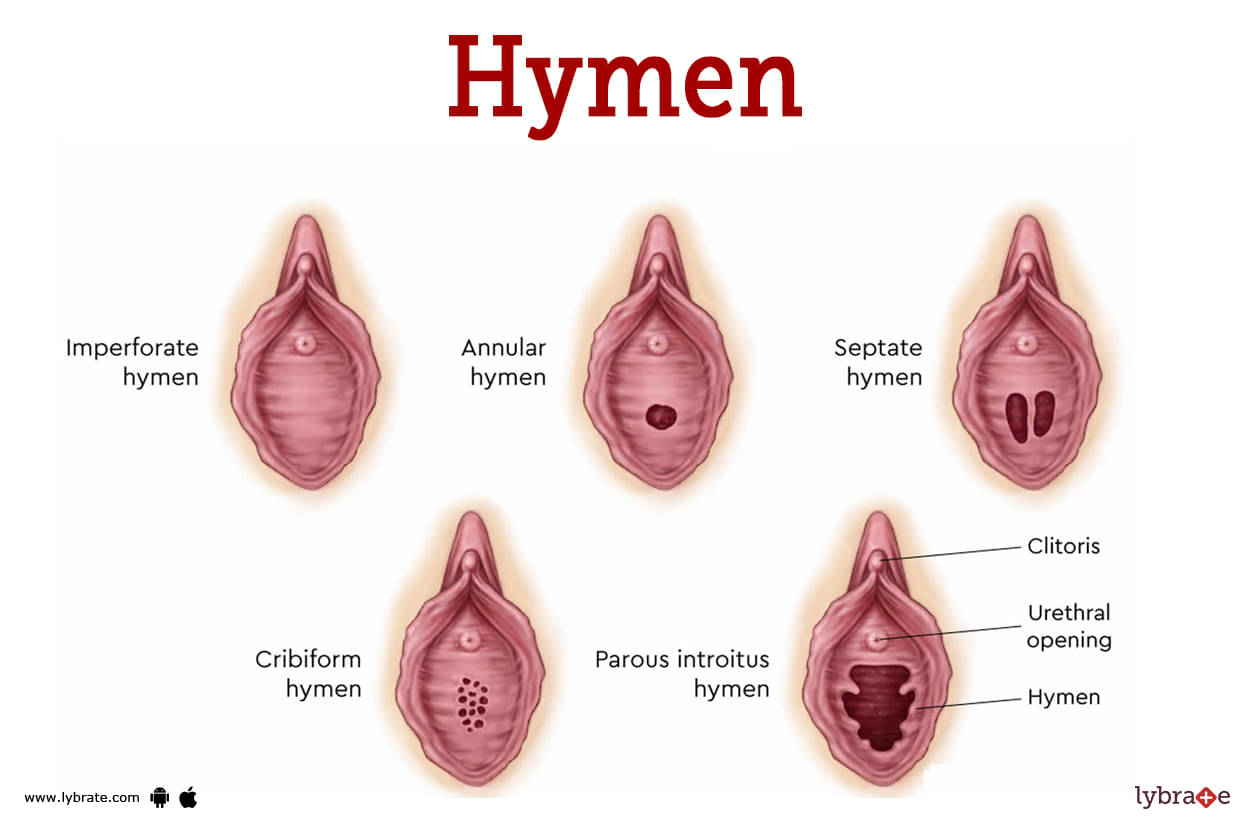Hymen (Female Anatomy): Image, Functions, Diseases and Treatments
Last Updated: Jun 27, 2023
Hymen Image
The hymen is a tiny, delicate flap of tissue that covers the vaginal entrance. Fetal tissue remnants organise into this structure. Your hymen's size, shape, and thickness are all one-of-a-kind characteristics that may evolve over time.
The hymen is a circular band of tissue that typically surrounds the cervix during birth. Sometimes it will cover the entire opening to your vagina, and other times it will only cover the bottom. In extremely unusual circumstances, menstrual problems can arise because the hymen completely covers the vaginal opening.
Functions of Hymen
The hymen, which forms the base of the vaginal opening, is crescent-shaped. Covering the vaginal entrance and causing difficulties occurs very seldom. While most infants will have an annular hymen, this will usually transform into a crescentic hymen by the time they are in elementary school.
What does a hymen look like?
The skin around your vagina is the same colour as your hymen (flesh-colored). It might shape itself like a crescent moon underneath your vaginal entrance or totally encircle it.
Because it hasn't had time to wear down, the hymen will be more noticeable in neonates. If your hymen is broken, it may seem as a little piece of tissue pushed to the side. A ripped hymen is difficult to detect and cannot be felt with your finger. It may merge back into the vaginal entrance in some circumstances.
Where is my hymen located?
Your hymen can be located anywhere from the middle to the side of your vaginal orifice, and it can be any size or form. Both annular hymens (which completely round the vaginal opening) and crescentic hymens are extremely prevalent (shaped like a crescent moon). These are typical sitting and standing positions. Vaginal openings are located in the hollow of annular hymens, making them look like donuts.
What is a hymen made of?
The hymen is a flexible tissue that moves with you. It is slightly thicker at birth, but it deteriorates and loses suppleness with time as a result of hormones, activities, tampon inserting, or intercourse.
Your hymen is created as your vagina develops throughout foetal development. Initially, your vagina is a solid tube. The fragments of the tube form your hymen when the tube dissolves and the vaginal aperture grows.
Types of Hymen
- Annular or crescent-shaped hymen: These are considered the normal hymen forms. At birth, the hymen usually forms a doughnut around the vaginal entrance (annular hymen). The form then shifts to a crescent.
- Cribriform hymen: A condition in which your hymen has several tiny holes. You might be able to menstruate via the perforations, but tampons would be difficult to put.
- Imperforate hymen: When your hymen totally covers your vaginal opening. This rare illness affects one in every 1,000 girls. This means that during your period, blood cannot exit your vagina. It will instead back up into your vagina, causing agony.
- Microperforate hymen: Except for a little hole, your hymen covers your whole vaginal opening. Period blood can flow through that little hole, but inserting or removing a tampon may be challenging.
- Septate hymen: Your hymen has an additional portion of tissue, making it appear to have two hymens. Behind the two pieces of tissue is your vaginal entrance. Tampons will be difficult to insert or remove for people who have a septate hymen.
Hymen Conditions and Disorders
- Annular or crescent-shaped hymen: These are regarded as the hymen's usual forms. The hymen often forms a donut-shaped protective barrier around the vaginal opening during birth (annular hymen). It then assumes a crescent shape.
- Cribriform hymen: An issue when your hymen has a lot of little holes in it. Although you might be able to menstruate through the perforations, inserting tampons would be challenging.
- Imperforate hymen: When the vaginal opening is completely enclosed by the hymen. This uncommon condition affected one in 1,000 girls. This proves that blood cannot escape your vagina while you are menstruating. As a result of backing up into your vagina, it will instead cause pain.
- Microperforate hymen: Your hymen fully seals off the entry to your vagina, leaving only a little hole. Although menstrual blood can pass through that little hole, it may be challenging to insert or remove a tampon.
- Septate hymen: The hymen seems to have two hymens because of an additional portion of tissue attached to it. In between the two pieces of tissue is where your vaginal opening is. Tampon insertion and removal will be difficult for those with a septate hymen.
- Stenosis: Hymenal stenosis, which causes difficulty using tampons and having sex, is the thickness or narrowing of the hymenal orifice.
- Prolapse: a bodily part, such as the rectum or vagina(hymen) , that is prone to bulging or falling out due to weakening supporting tissues.
- Lichen sclerosus: Lichen sclerosus (LS) is a persistent dermatosis that favours keratinized vulvar skin. It has two diagnostic histopathologic features: lichenoid tissue response and dermal collagen homogenization. While LS is typically found on the skin, it can also affect the squamous mucosa.
- Genital herpes: a typical sexually transmitted infection marked by genital sores and agony.Both men and women are susceptible to the condition, which is caused by the herpes simplex virus.
- Bacterial vaginosis: Women who are of childbearing age make up the majority of bacterial vaginosis patients. Douching frequently or engaging in unguarded sexual behaviour can put someone at risk.
- Bartholin’s cyst: A fluid-filled cyst on a Bartholin's gland that lubricates the vagina.Bartholin's cysts are typical. Fluid may accumulate if the aperture of the Bartholin's gland is obstructed due to an injury or infection.Inclusion cyst: The most typical cutaneous cysts are epidermal inclusion cysts, which can develop anywhere on the body. Under the skin's surface, these cysts often appear as fluctuant nodules with prominent centre puncta.
- Epidermal cysts: When the ducts leading to the sebaceous glands get obstructed, epidermal cysts may form. These glands' secretions then build up beneath the skin's surface. Both of these cysts gradually grow larger and can occasionally develop an infection. Sexual contact may be uncomfortable if infected cysts are red and sensitive.
- Vulvodynia: In the region of the vaginal opening, there is persistent, unexplained pain. The discomfort of vulvodynia can make some activities, including prolonged sitting or having intercourse, intolerable.
Hymen tests
- Simple Pelvic Exam: With one hand, the doctor will gently press on the outside of your lower abdomen, and with the other, he or she will slide two fingers into your vagina while wearing gloves and lubricant. During this part of the examination, your doctor will evaluate the size and shape of your uterus and ovaries, noting any uncomfortable areas or odd growths.
- NAAT: A nucleic acid test is a diagnostic procedure that can identify a specific species or subspecies of organism in a sample of blood, tissue, urine, etc. by determining the presence of an identifiable nucleic acid sequence.
- MRI: Subacute bleeding episodes and the blood components in hematometrocolpos are followed by signal changes.
- Cotton Swab Test: Your doctor gently examines your vulvar region with a moistened cotton swab to look for any localised, particular pain spots.
How do I know if my hymen is healthy?
You will likely detect a hymen problem in adolescence. During your menstruation, you can't use tampons.
Your hymen may conceal your vaginal entrance and prevent your menstruation. By adolescent years, your doctor can discover a hymen problem.
Hymen Treatment
- Hymenectomy: A hymenectomy is the surgical removal of extra hymen tissue that covers a woman's vaginal opening entirely or partially.
- Hymenoplasty surgery: The hymen is intended to be repaired during hymenoplasty surgery. After sexual activity, the hymen, which is normally broken, is silently repaired. Having a hymenoplasty performed for personal convenience or after a sexual assault is common. It is also known as Hymenorrhaphy.
- Biofeedback therapy: By teaching you how to relax your pelvic muscles and manage how your body reacts to the symptoms, this therapy can help you feel less pain.
- Pelvic floor therapy: The pelvic floor muscles, which support the uterus, bladder, and intestine, are often tight in vulvodynia patients. Relaxing exercise may help relieve hymen pain.Although the hymen serves no biological role, there are several myths and incorrect assumptions about what it implies if your hymen covers your vaginal opening. Some cultures believe that your hymen determines whether or not you've previously had sex, however this is not true.
How do you know if your hymen is still there?
You won't be able to tell if your hymen is still intact. Light spotting or bleeding, pain, or visible skin around your vaginal entrance may be caused by a damaged hymen. In most circumstances, your hymen will degenerate progressively over time.
It may regress to your vagina or appear as a little flap of skin once it splits. Inspect yourself in the light to see if you still have your hymen. Your hymen can be visible as a piece of tissue all around the bottom of your opening of the vagina.
Frequently Asked Questions (FAQs)
How do you know if your hymen is still a virgin?
What does a hymen look like?
Does every girl have a hymen?
How many days does it bleed after hymen breaks?
Is it compulsory for a virgin to bleed?
What happens if a girl doesn't bleed for the first time?
What is the Colour of the hymen?
Table of content
Find Gynaecologist near me
Ask a free question
Get FREE multiple opinions from Doctors



